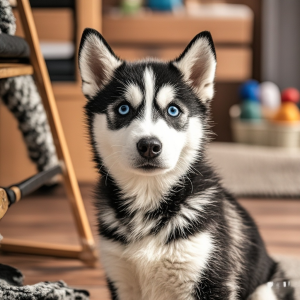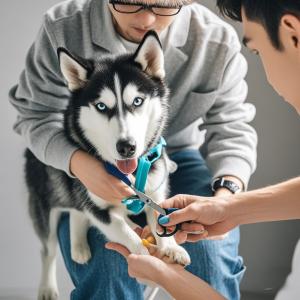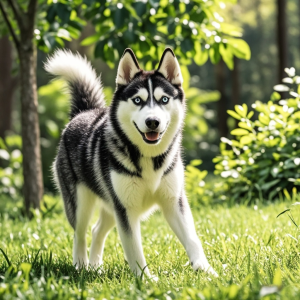The Siberian Husky is a popular pet among pet lovers due to its beautiful appearance and unique personality. However, newly adopted Siberian Huskies require special care and attention to ensure their healthy growth and adaptation to their new environment. This article will provide comprehensive guidance from various professional perspectives on how to care for newly adopted Siberian Huskies.
I. Preparing for the New Member
1. Home Environment Preparation
a. Safe Area
Before bringing the Siberian Husky home, ensure that there is a safe and comfortable area for it to adapt to its new environment. This area should be away from noise and distractions, and provide a comfortable bed, water, and suitable toys.
b. Removing Dangerous Items
Siberian Huskies are curious dogs, and they may come into contact with dangerous items while exploring their home. Remove harmful substances from the home, such as electrical wires, small objects, and toxic plants, to prevent the Siberian Husky from accidentally consuming or getting hurt.
2. Essential Supplies Preparation
a. Food and Water
Prepare high-quality dog food and clean water for the Siberian Husky. In the initial stage, you can choose dog food specially designed for puppies to ensure a balanced diet.
b. Dog House or Bed
Choose a comfortable dog house or bed and place it in the Siberian Husky’s safe area to provide a warm and comfortable resting place.
c. Toys and Chew Toys
Provide suitable toys and chew toys to help the Siberian Husky through the teething period and meet its chewing and playing needs.
II. Initial Adaptation and Training
1. Adapting to the New Environment
a. Gradual Adjustment
Newly adopted Siberian Huskies need time to adapt to their new environment, so don’t rush them into too many new things. Give them enough time and space to gradually become familiar with their new home.
b. Gentle Treatment
During the Siberian Husky’s adaptation to the new environment, treat it gently and avoid sudden movements or loud noises to prevent it from feeling afraid and uneasy.
2. Basic Behavior Training
a. Toilet Training
Start potty training your Siberian Husky as soon as it comes home. Choose a designated spot for your dog to go potty, take it there, and reward and encourage it to help establish good potty habits.
b. Basic Command Training
Start with simple commands such as “sit,” “wait,” and “come,” and use positive reinforcement methods to train your Husky. Give your Husky an appropriate reward after each command is completed, such as a treat or a pat on the head, to help him develop good behavior habits.
3. Socialization Training
a. Interaction with Different People and Animals
During the puppy stage of the Siberian Husky, gradually guide it to interact with different people and animals to help it build positive social experiences. Regularly take the Siberian Husky to dog parks, pet gatherings, etc. to increase its social experience.
b. Adapting to different environments
Take your Huskies to different environments such as streets, parks, and shops to help them adapt to various life situations. Gradually increase the complexity of the environment to help your Huskies overcome fear and anxiety and build confidence.
III. Health Management and Nutrition
1. Diet Management
a. High-Quality Dog Food
Choose high-quality dog food to ensure that it is nutritionally balanced. During the puppy stage, you can choose dog food specially designed for puppies, which contains rich protein, fat, vitamins, and minerals.
b. Regular Diet
Establish a regular feeding routine, feeding your Siberian Husky at set times each day and avoiding overfeeding. During puppyhood, it is recommended to feed your Siberian Husky 3-4 times a day, gradually reducing to 2 times a day.
c. Avoid Human Food
Avoid feeding your Siberian Husky human food, especially chocolate, grapes, and onions, which are harmful to dogs. Ensure the safety and health of its diet.
2. Health Checks and Vaccinations
a. Regular Health Checks
Bring Siberian Huskies to the vet for regular health checks to ensure their good health. This is especially important during puppyhood, as timely detection and resolution of potential health issues are crucial.
b. Timely Vaccinations
Follow the vet’s advice and give vaccinations on schedule to prevent common infectious diseases. Vaccines include rabies vaccine, canine distemper vaccine, and canine parvovirus vaccine, etc., to ensure Siberian Huskies’ immunity.
3. Parasite Control and Prevention
a. Internal and External Parasite Control
Regularly control internal and external parasites to prevent infections. Internal parasite control is usually done monthly, while external parasite control depends on the need.
b. Regular Checks
Regularly check Siberian Huskies’ skin and coat for signs of parasites, such as fleas and ticks. Take action immediately if any signs are found, to prevent infections and spread.
IV. Daily Care and Exercise
1. Coat Care
a. Regular Brushing
Siberian Huskies’ coat needs regular brushing, especially during shedding season. Daily brushing can remove loose hair and prevent hairballs, And keep the fur clean and healthy.
b. Bathing and Grooming
Bath your Siberian Husky as needed, usually once a month. Use special dog grooming products, and avoid using human shampoo and bath products to prevent skin irritation and allergies.
2. Oral Care
a. Regular Brushing
Start brushing your Siberian Husky’s teeth from a young age to develop the habit. Use a dog-specific toothbrush and toothpaste, brushing 2-3 times a week to maintain good dental health.
b. Chew Toys and Teething Aids
Provide appropriate chew toys and teethers to help your Siberian Husky clean its teeth and massage its gums, preventing tartar and gingivitis.
3. Nail Trimming
a. Regular Trimming
Regularly trim your Siberian Husky’s nails, usually once a month. Long nails can affect walking and posture, and may even cause nail breakage and infection.
b. Proper Trimming Techniques
Use a special dog nail trimmer and trim carefully, avoiding cutting the blood vessels and nerves. You can also ask a professional pet groomer to trim them, ensuring safety and correctness.
4. Care for Ears and Eyes
a. Regular Ear Checks and Cleaning
Regularly check your Siberian Husky’s ears, looking for signs of bad odor, discharge, and redness. Use a special ear cleaner to gently wipe the ear canal, keeping the ears clean and healthy.
b. Eye care
Check your Siberian Husky’s eyes every day and remove any discharge from the corners. Use warm water or a special eye wash to gently clean the eyes and keep them clean and healthy.
5. Foot Care
a. Checking and Cleaning the Feet
Regularly check the pads and between the toes of your Siberian Husky, looking for signs of wounds, foreign objects, and infections. Use warm water and a soft towel to clean the feet, keeping them dry and healthy.
b. Foot Care Products
You can use specialized foot care products, such as paw protectant cream, to prevent cracking and wear. It’s especially important to protect your Siberian Husky’s feet during cold winters and hot summers.
V. Mental Health and Behavior Management
1. Building Good Relationships
a. Love and Companionship
Huskies need their owner’s love and companionship, and establishing good relationships is very important. Spend time each day interacting, playing, and training with your husky to strengthen the bond and trust.
b. Positive Reinforcement
Use positive reinforcement methods, such as giving treats, petting, and praise, to encourage your husky’s good behavior. Avoid using punishment and threats to prevent fear and mistrust.
2. Dealing with Separation Anxiety
a. Gradually Adjusting to Being Alone
A Siberian Husky that has just been brought home may display separation anxiety, so it is important to gradually adjust to being alone. Start by leaving for short periods of time, then gradually increasing the amount of time away, allowing the Siberian Husky to gradually adjust.
b. Providing a Sense of Security
During alone time, provide the Siberian Husky with its favorite toys and blankets to provide a sense of security. Use anxiety-relief toys or items, such as stuffed snack toys, to help it get through alone time.
3. Prevent and manage destructive behavior
a. Provide adequate exercise and stimulation
Ensure that your Siberian Husky gets enough exercise and mental stimulation every day to burn off its energy and prevent destructive behavior. Walking, running, games, and training classes are effective ways to meet its needs.
b. Behavior correction and training
Correct your Siberian Husky’s bad behavior through positive reinforcement. If you notice it biting furniture or chewing items, immediately stop it and guide it to use appropriate toys. After each correction, give appropriate rewards and encouragement to help it develop good behavior habits.
4. Professional Consultation Help
a. Seek Help from a Veterinarian or Pet Behavior Expert
If Siberian Husky exhibits severe behavioral problems such as persistent separation anxiety or aggressive behavior, consulting with a veterinarian or pet behavior expert can be helpful. Professional guidance and advice can help solve complex behavioral problems and ensure the Siberian Husky’s psychological well-being.
A Siberian Husky that has just been brought home requires special care and attention, from preparing the home environment, basic behavior training, health management, daily care to mental health and behavior management. Owners need to take good care of them with scientific care methods and professional guidance. With these efforts, Siberian Huskies can grow up healthily and happily, becoming a close member of the family.